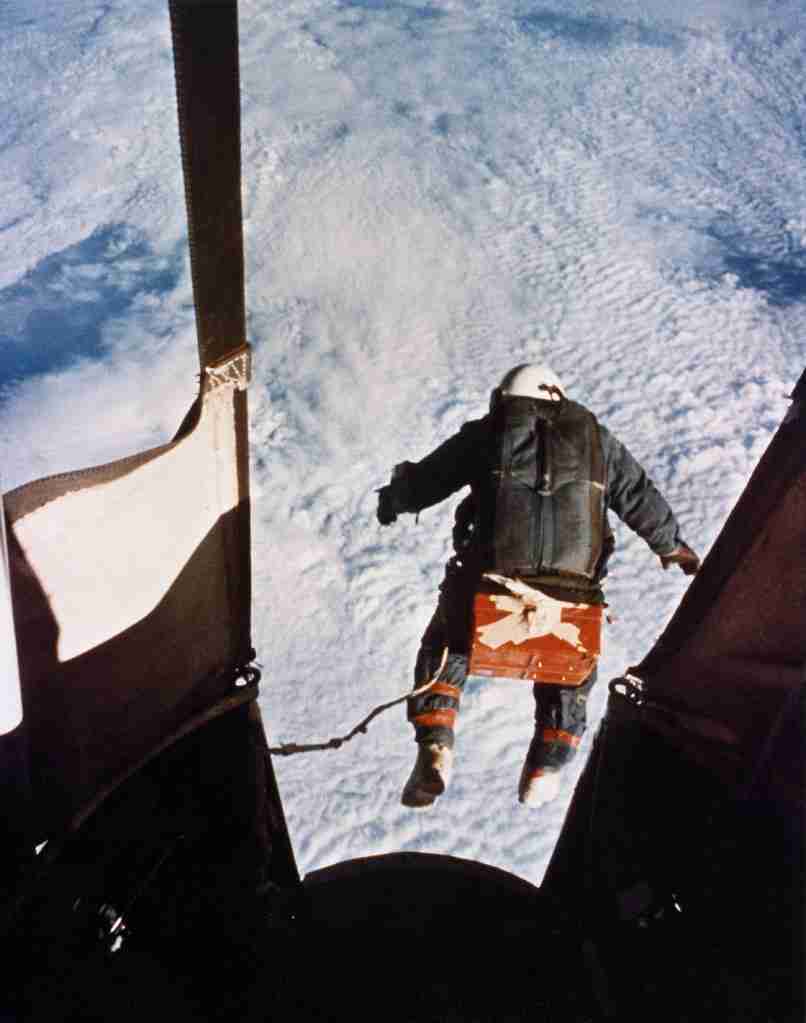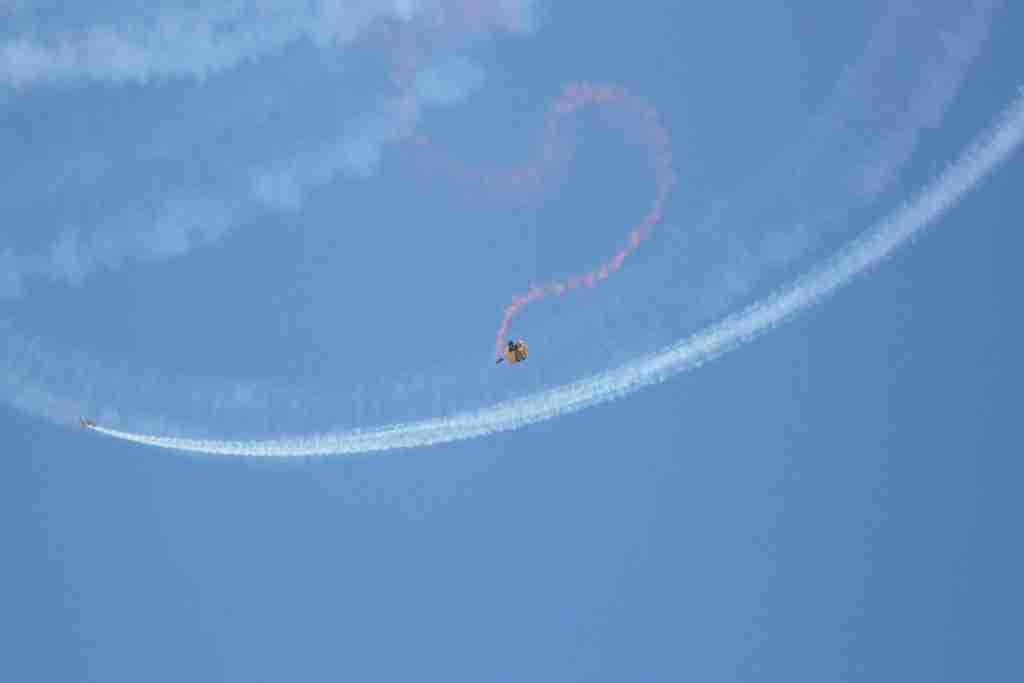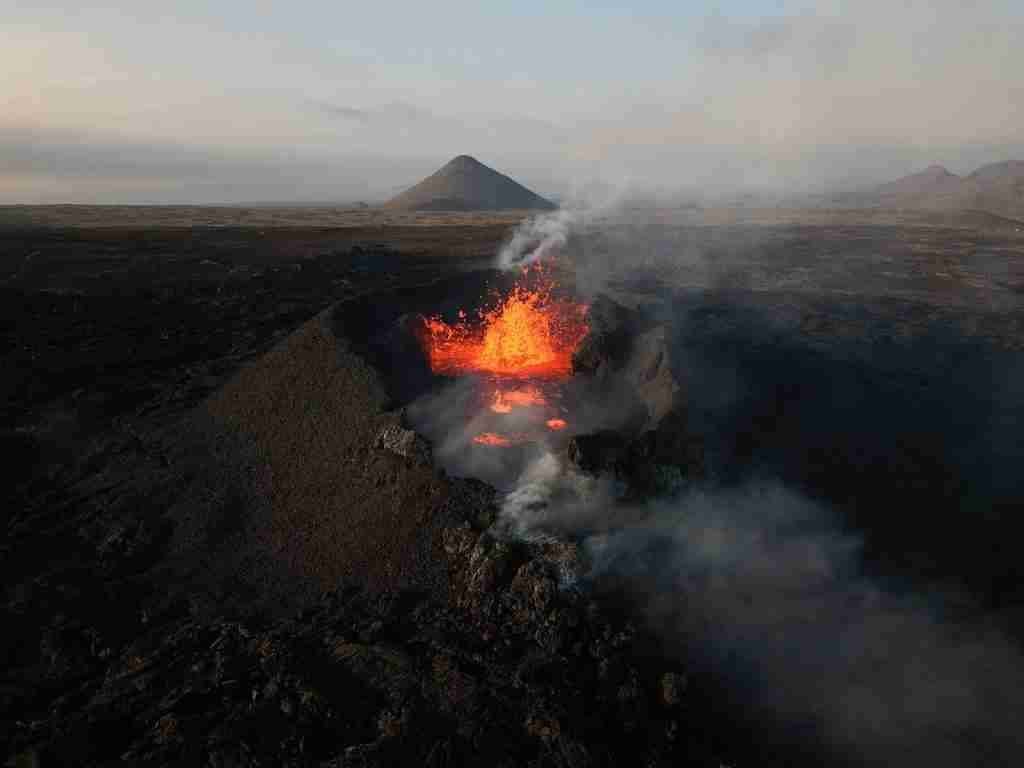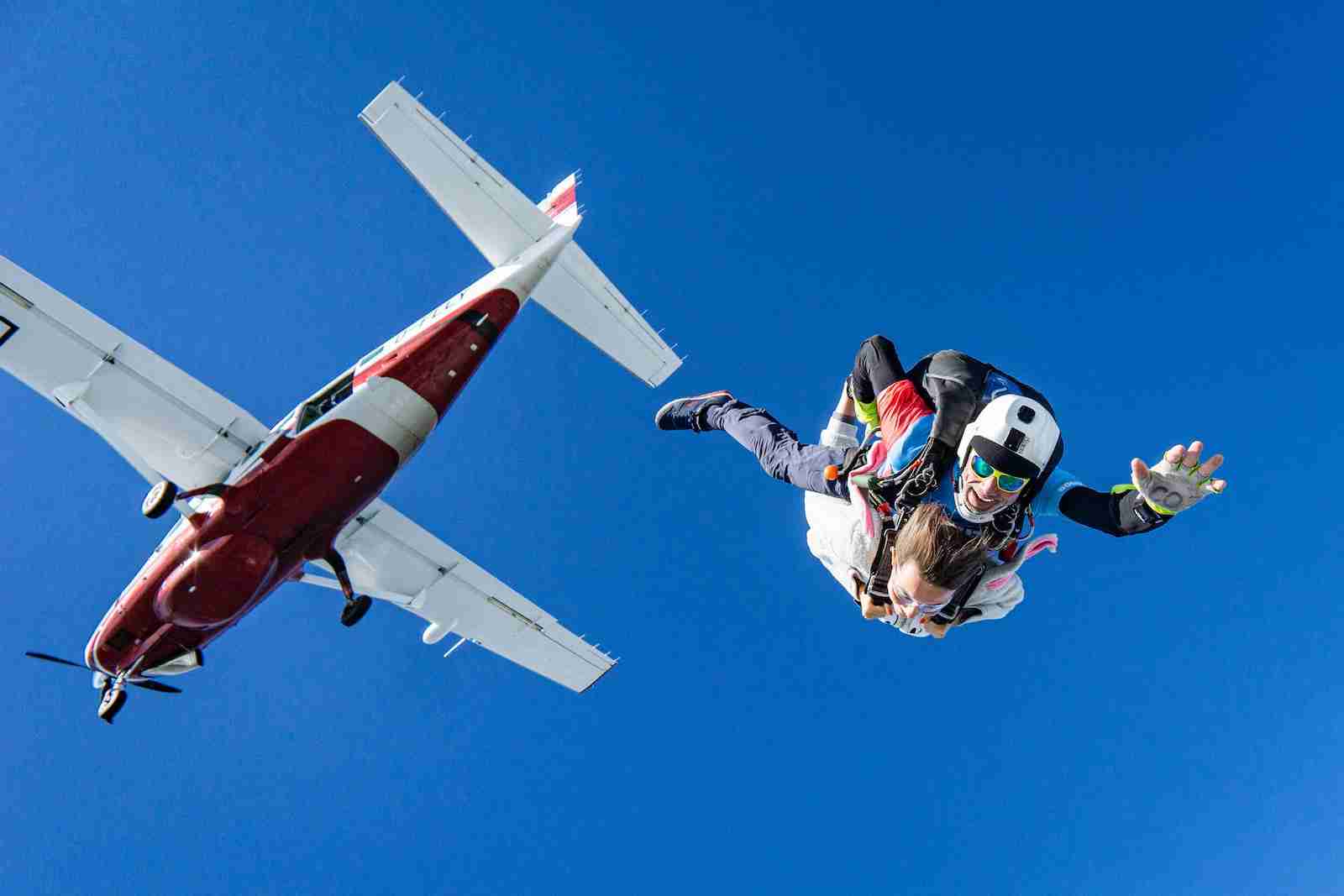26 Fun Facts About Skydiving | You Never Knew
1. Leo Valentin’s “birdman” suit inspired modern wingsuits.
Leo Valentin’s innovative “birdman” suit, crafted in the 1950s, was a pivotal step towards the development of contemporary wingsuits, enabling skydivers to emulate the soaring flight of birds.
His vision, by incorporating wing-like extensions, laid the groundwork for the cutting-edge gear now used for wingsuit proximity flying. Today, these suits allow jumpers to achieve a unique and exhilarating sensation of flight, enhancing the adventure of skydiving.
2. Jumpers reach terminal velocity (120mph) in 12 seconds.
Skydiving’s intensity is magnified as jumpers swiftly accelerate to their maximum speed of 120 miles per hour within a mere 12 seconds of freefall.
This swift acceleration is a testament to the relentless force of gravity, providing an electrifying rush that makes skydiving a heart-pounding experience from the moment of exit.
3. Jumps from a hot air balloon predate planes.
The roots of skydiving delve into history long before the era of modern aircraft. Pioneering skydivers took their daring leaps from hot air balloons, marking a foundational chapter in the sport’s rich history.
These early adventurers laid the foundation for the thrill-seekers who now take to the skies from planes, commemorating the origins of an exhilarating pastime.
4. Record jump from 102,000 ft was by Joe Kittinger.

Joe Kittinger’s remarkable skydive from the astonishing altitude of 102,000 feet, as part of Project Excelsior in 1960, remains an enduring testament to human high-altitude skydiving.
This historic leap not only defied the bounds of what was thought possible but also advanced our understanding of how humans could navigate extreme altitudes. Kittinger’s courageous achievement pushed the envelope and inspired generations of skydivers and adventurers.
5. “CRW” stands for Canopy Relative Work.
“CRW,” an abbreviation for Canopy Relative Work, signifies the breathtaking art of forming intricate formations in the sky by linking open parachutes during freefall.
This discipline demands not only skill but impeccable teamwork, as skydivers synchronize their movements to create stunning displays of human artistry against the backdrop of the open sky. It is a captivating facet of the sport that showcases the technical finesse and collaborative spirit of skydivers.
6. Static line jumps use a cord to deploy the chute.
In static line jumps, the initiation of the parachute deployment is an automated process. As the jumper exits the aircraft, a cord connected to the plane deploys the parachute, ensuring a safe and reliable method for novices to make their first forays into the world of skydiving.
This automated mechanism provides a secure entry point for those new to the sport, allowing them to experience the thrill of freefall with added peace of mind.
7. “Freeflying” includes flips and spins mid-air.
Within the realm of skydiving, “freeflying” emerges as a dynamic discipline that allows participants to add a spectacular layer of acrobatics to their freefall experience.
It involves mid-air flips, spins, and other gravity-defying maneuvers, expanding the boundaries of what can be achieved in the skies. Freeflyers harness the full spectrum of their skills and creativity to create a mesmerizing display of human flight.
8. How would you exit a plane?
Skydivers must exit the plane in a controlled manner to ensure a safe freefall. They typically exit facing forward, with their feet and knees together and their arms at their sides.
This position helps to streamline their body and reduce air resistance.
9. Skysurfing combines surfing and skydiving.
Skysurfing is a thrilling hybrid of skydiving and surfing, as jumpers ride specially designed boards during freefall.
This dynamic discipline adds an extra layer of adventure to the sport, allowing participants to carve the sky with surf-inspired maneuvers.
10. Swooping contests test precision landings.
Swooping competitions challenge the most skilled skydivers to showcase their accuracy and control as they execute precision landings on designated targets.
These contests blend the thrill of high-speed descent with the finesse required to touch down with pinpoint accuracy, making them a captivating aspect of the sport that demands both dexterity and daring.
11. “BASE” jumping began with El Capitan jumps.
The origins of “BASE” jumping, an extreme form of skydiving from fixed objects like cliffs and buildings, can be traced back to audacious leaps from iconic landmarks such as El Capitan in Yosemite National Park.
These early pioneers laid the foundation for the daring discipline, which continues to attract adventurers who seek to push the limits of human flight.
12. Felix Baumgartner’s Leap From Space in 2012.
In 2012, Felix Baumgartner became the first person to break the sound barrier in freefall, jumping from over 24 miles above Earth in a Red Bull Stratos mission.
His journey was fraught with danger, as he entered a terrifying spin and had to fight to regain control. But he persevered, landing safely and setting a new world record.
13. Paraplegics can skydive with adapted gear.
The development of specialized equipment and tandem skydiving techniques has made it possible for individuals with paraplegia to experience the sheer thrill of skydiving.
These adaptive measures break down physical barriers, allowing everyone, regardless of mobility challenges, to partake in the exhilarating world of freefall.
14. The oldest skydiver, Bryson William Verdun Hayes, was 101.
Bryson William Verdun Hayes made history as the oldest skydiver, achieving this remarkable feat at the astounding age of 101.
His daring jump exemplified the age-defying spirit of skydiving and served as an inspiring reminder that adventure knows no age limits.
15. Reserves deploy if the main chute fails.
Safety is paramount in skydiving, and as a vital precaution, every skydiver is equipped with a reserve parachute.
This backup chute automatically deploys in case of any issues with the primary parachute, ensuring an additional layer of security and enabling jumpers to descend safely.
16. Night jumps with LED suits are exhilarating.

Night skydiving takes on a whole new dimension of excitement with the use of LED suits.
These illuminated suits create enchanting light trails as jumpers descend through the darkened sky, transforming the experience into a visually stunning spectacle that is both thrilling for the participants and captivating for onlookers.
Night jumps with LED suits showcase the fusion of technology and adventure in the world of skydiving.
17. Bird strikes can happen during freefall.
Occasionally, the serendipitous interaction of birds and skydivers occurs during freefall, offering unique and unforgettable moments in the air.
These spontaneous encounters add an element of the natural world to the skydiving experience, creating extraordinary stories to share.
18. Skydivers can experience “canopy collapse”.
Canopy collapse is a challenging phenomenon that can occur during a skydive when the parachute loses its aerodynamic shape.
This results in a sudden loss of lift and control, requiring expert handling to regain stability during the descent. It is a test of a skydiver’s skill and composure.
19. Freefall can induce temporary deafness.
The intense wind noise and air pressure fluctuations during freefall can occasionally lead to temporary hearing impairment.
It underscores the extreme conditions that skydivers brave as they plummet from the sky, experiencing a sensory dimension that is uniquely their own.
20. Smoke trails create stunning visual effects.

Smoke trails, commonly used in airshows and aerial displays, enhance the visual spectacle of skydiving.
These mesmerizing trails add a captivating element to the sport, turning every jump into a dynamic performance that enchants both participants and spectators.
21. Birds sometimes mimic skydivers in flight.
On rare occasions, birds have been observed mimicking the movements of skydivers during freefall, creating a fascinating interplay between humans and the natural world in the skies.
These spontaneous connections highlight the harmony of both realms, united in the shared experience of flight.
22. Smokejumpers combat wildfires from the air.
Smokejumpers are elite firefighters who employ skydiving skills to parachute into remote wilderness areas and combat wildfires.
Their missions involve the fusion of bravery, environmental conservation, and a commitment to safeguarding our natural landscapes.
23. “Hop ‘n’ Pops” are low-altitude practice jumps.
“Hop ‘n’ Pops” serve as training exercises conducted at relatively low altitudes, typically around 3,000 feet.
These jumps allow skydivers to refine specific skills such as canopy control and precision landings, making them an essential part of a jumper’s skill development.
24. Jumps over active volcanoes are awe-inspiring.

Skydiving over active volcanoes is a heart-pounding endeavor that offers unparalleled views and pushes the boundaries of extreme sports.
The juxtaposition of human adventurers against the backdrop of volcanic activity makes for a breathtaking and audacious spectacle.
25. World Records for large formations exist.
Skydivers frequently come together to set world records for the largest formation jumps.
These awe-inspiring feats require meticulous planning, impeccable execution, and extraordinary teamwork, symbolizing the spirit of unity and accomplishment in the skydiving community.
26. Wind tunnel training refines skydiving skills.
Wind tunnels, indoor facilities that replicate the sensation of freefall, provide skydivers with a controlled environment to hone their skills.
These facilities allow jumpers to perfect their body positioning, experiment with new maneuvers, and refine their abilities, ultimately enhancing their performance in the actual skydiving environment.
FAQs
A skydive is a thrilling recreational activity where individuals jump from an aircraft and descend to the ground using a parachute.
Skydive Dubai is a world-renowned skydiving center located in Dubai, United Arab Emirates, offering breathtaking aerial experiences over the iconic Dubai skyline.
Skydive Dubai offers a range of experiences, including tandem skydives for beginners, accelerated freefall courses for those seeking to become licensed skydivers, and special events like competitions and record attempts.
Yes, Skydive Dubai caters to both beginners and experienced skydivers. Tandem jumps are available for first-timers, and training courses are offered for those interested in pursuing solo skydiving.
Skydives in Dubai provide breathtaking views of the city’s iconic landmarks, including the Palm Jumeirah and the Dubai Marina. The experience is often described as awe-inspiring.







